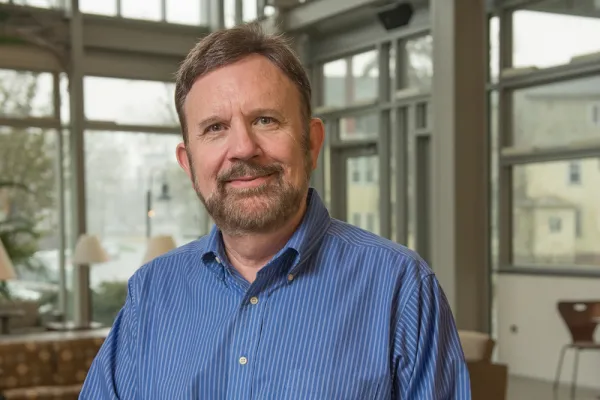Global Hunt for COVID-19 Clues
Research & Inquiry

Published September 21, 2020
As the worldwide coronavirus pandemic ramped up last spring, pointing to an urgent need for diagnostic testing, Steve Williams, Gates Professor of Biological Sciences and Biochemistry, had already begun adapting a portable testing kit for use in diagnosing COVID-19 cases in the developing world.
Williams and four fellow scientists had previously developed and written about a testing kit, contained in a 10-pound backpack, for diagnosing lymphatic filariasis, a disfiguring tropical disease commonly called elephantiasis. Their research caught the attention of the Bill and Melinda Gates Foundation, an organization that is urging the federal government to step up its efforts on diagnostic testing; diagnosing viral or parasitic disease—whether lymphatic filariasis or COVID-19—is considered a critical defense against its spread.
Here, Williams—who is director of the National Institutes of Health Filariasis Research Reagent Resource Center, Molecular Division, as well as a member of the World Health Organization’s Diagnostic Technical Advisory Group (DTAG) for Neglected Tropical Diseases—discusses his research and how it is relevant to COVID-19.
After reading in a science journal about your diagnostic test kit—the backpack PCR (polymerase chain reaction)—the Gates Foundation asked you to submit a proposal for a kit that could offer a COVID-19 test for rapid deployment in developing countries. What attracted them to your project?
The idea of a testing system that can be rapidly deployed at reasonable cost appealed to the Gates Foundation. The big advantages to our system are that it is 1) compact and lightweight, 2) simple— easy to train field personnel, and 3) inexpensive.
Who are your fellow researchers, listed as authors, in the article? Is it a worldwide group?
All of the authors are from my lab. The first author, Weam Zaky, is Egyptian and worked for me for more than 10 years. She’s now at Walter Reed [National Military Medical Center]. Francesca Tomaino ’12 was an undergrad working in my lab. Nils Pilotte, a Ph.D. student of mine at the time, is now a postdoctoral fellow in my lab. Sandra Laney AC ’96 worked for me for 15 years and was also a graduate student in my lab. She was at the Gates Foundation at the time of publication of the paper.
What has been the outcome of your proposal?
Due to the fierce competition with everyone working on COVID-19, our backpack PCR was not selected for development. However, there is still great interest in deploying the backpack PCR for the screening of tropical diseases and diseases transmitted by mosquitoes (both parasitic and viral). In addition to lymphatic filariasis/elephantiasis, river blindness and other parasitic diseases, we also have tests for Zika, chikungunya, dengue, yellow fever and others. There is a big push now to screen mosquitoes using our test for both parasites and viruses simultaneously. This work is funded through the Bill and Melinda Gates Foundation and the Task Force for Global Health.
With so many scientists like you studying global diseases, why has this pandemic proven so difficult to control?
The world has grown very small. When a new disease spills over from animals into the human population, it can spread very quickly. The international research community needs to band together to fund better surveillance so that new emerging diseases can be detected more quickly and rapid action can be taken to limit spread. We humans are not very good at such cooperation and such preventive measures. We tend to wait until disaster strikes before taking serious action. Improvement will require leadership from somewhere. The U.S. has not stepped up to the plate, and the WHO [World Health Organization] is woefully underfunded for such a monumental task.
In your experience as a molecular biologist, what worries you about COVID-19?
What concerns me most is that COVID-19 could have been much worse. If the COVID-19 death rate was as high as, say, the 1918 flu, we’d be talking about millions of deaths in the U.S. instead of tens of thousands. In a way, we are lucky that the fatality rate is as low as it is. A disease with a higher fatality rate and one that is more easily spread could jump into the human population at any time. I worry that unless we learn our lessons from COVID-19 and are better prepared, the next one could be worse. We don’t seem to be making much progress on overall preparedness.
What does this moment—contending with a global viral pandemic—mean to you as a scientist?
It is both an exciting time and a very worrisome development. All of the attention on COVID-19 is taking away funding from other disease research, and we have a significant risk of losing important gains made in the fight against NTDs [neglected tropical diseases] and other diseases. My lab being shut down for a long period of time has limited our ability to be competitive for funds. This had a lot to do with our lack of competitiveness on the COVID-19 work. I couldn’t promise we’d be able to do the lab work in a timely fashion.
Meanwhile, I was recently named to the WHO’s Diagnostic Technical Advisory Group. The subcommittee that I’ve been assigned to is on neglected tropical diseases, which are my specialty. However, I do get some inside intel on COVID-19. This action “task force” has turned out to be very interesting and a huge amount of work!
This story appears in the Fall 2020 issue of the Smith Alumnae Quarterly.